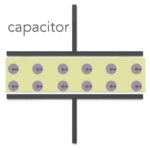Explore the electric displacement field equation, its significance, applications, and an example calculation in this insightful article.
Understanding the Electric Displacement Field
The electric displacement field, often represented by the symbol D, is an essential concept in electromagnetism. It plays a crucial role in understanding the behavior of electric fields in the presence of dielectric materials. This article will explore the electric displacement field equation, its significance, and its applications in various contexts.
The Electric Displacement Field Equation
The electric displacement field is related to the electric field (E) and the polarization of the dielectric material (P). The equation that defines the electric displacement field is:
D = ε0E + P
Here, ε0 is the vacuum permittivity, a constant value that measures the ability of free space to permit electric field lines. The polarization, P, represents the separation of charges in a dielectric material when subjected to an electric field. This polarization is the result of the alignment of the material’s dipoles in response to the applied electric field.
Significance of the Electric Displacement Field
The electric displacement field is a vital concept because it allows us to study the behavior of electric fields in dielectric materials. Dielectric materials are non-conductive substances that can store electrical energy by polarizing in the presence of an electric field. This ability is useful in numerous applications, such as capacitors and insulators.
Moreover, the electric displacement field helps in understanding the complex interactions between electric fields and dielectric materials, making it possible to design efficient and reliable electrical devices.
Applications of the Electric Displacement Field
- Capacitors: The electric displacement field is instrumental in determining the energy stored in capacitors. Capacitors are devices that store electric charge and energy by creating an electric field between two conductive plates separated by a dielectric material. The electric displacement field aids in calculating the capacitance and the amount of energy stored.
- Insulators: The electric displacement field helps in understanding the effectiveness of insulators in preventing the flow of electric charges. By evaluating the behavior of electric fields in dielectric materials, engineers can design better insulators for electrical systems.
- Electromagnetic Waves: In electromagnetic wave propagation, the electric displacement field is an essential component of the wave equation. It provides insight into the behavior of electromagnetic waves in different mediums, such as vacuum, air, or dielectric materials, and helps predict their propagation and interaction with other waves.
In conclusion, the electric displacement field is a fundamental concept in electromagnetism that offers valuable insights into the behavior of electric fields in dielectric materials. Its applications in capacitors, insulators, and electromagnetic wave propagation make it an indispensable tool in the field of electrical engineering and physics.
Example of Electric Displacement Field Calculation
Let’s consider a parallel plate capacitor with a dielectric material of relative permittivity εr = 4 inserted between its plates. The electric field between the plates is 2 x 104 N/C. We will calculate the electric displacement field, D.
First, we need to find the absolute permittivity of the dielectric material, which is the product of the vacuum permittivity (ε0) and the relative permittivity (εr):
ε = ε0εr
Since ε0 = 8.85 x 10-12 F/m and εr = 4, the absolute permittivity of the dielectric material is:
ε = (8.85 x 10-12 F/m) x 4 = 3.54 x 10-11 F/m
Now, we can calculate the polarization P using the relation:
P = εE – ε0E
Given the electric field E = 2 x 104 N/C, we have:
P = (3.54 x 10-11 F/m)(2 x 104 N/C) – (8.85 x 10-12 F/m)(2 x 104 N/C) = 5.32 x 10-6 C/m2
Finally, we can find the electric displacement field D using the equation:
D = ε0E + P
D = (8.85 x 10-12 F/m)(2 x 104 N/C) + 5.32 x 10-6 C/m2 = 7.08 x 10-6 C/m2
The electric displacement field D in the dielectric material of the parallel plate capacitor is 7.08 x 10-6 C/m2.



